2003 GMC SIERRA DENALI rear view mirror
[x] Cancel search: rear view mirrorPage 2 of 428

The 2003 GMC Sierra Denali Owner Manual a
Seats and Restraint Systems ........................... 1-1
Front Seats ............................................... 1-2
Rear Seats
............................................... 1-7
Safety Belts
.............................................. 1-8
Child Restraints
....................................... 1-30
Air Bag Systems
...................................... 1-57
Restraint System Check
............................ 1-73
Features and Controls
..................................... 2-1
Keys
........................................................ 2-2
Doors and Locks
....................................... 2-6
Windows
................................................. 2-1 0
Theft-Deterrent Systems ............................ 2-1 3
Starting and Operating Your Vehicle ........... 2-15
Mirrors
.................................................... 2-28
Onstar@ System
...................................... 2-33
HomeLink@ Transmitter
............................. 2-35
Storage Areas
......................................... 2-39
Instrument Panel
............................................. 3-1
Vehicle
Personalization
............................. 2-42
Instrument Panel Overview
.......................... 3-2
Climate Controls
...................................... 3-1 8
Warning Lights, Gages and Indicators
......... 3-24
Driver Information Center (DIC)
.................. 3-43
Audio System(s)
....................................... 3-61 Driving Your Vehicle
....................................... 4-1
Your
Driving, the Road, and Your Vehicle ..... 4-2
Towing
................................................... 4-45
Service and Appearance Care
.......................... 5-1
Service
..................................................... 5-3
Fuel
......................................................... 5-5
Checking Things Under the Hood
............................................. 5-10
All-Wheel Drive
........................................ 5-49
Rear Axle
............................................... 5-50
Front Axle
............................................... 5-51
Bulb Replacement
.................................... 5-52
Windshield Wiper Blade Replacement
......... 5-60
Tires
...................................................... 5-61
Appearance Care
..................................... 5-86
Vehicle Identification
................................. 5-94
Electrical System
...................................... 5-95
Capacities and Specifications
................... 5-1 04
Normal Maintenance Replacement Parts
.... 5-1 05
Maintenance Schedule
..................................... 6-1
Maintenance Schedule
................................ 6-2
Customer Assistance Information
.................... 7-1
Customer Assistance Information
.................. 7-2
Reporting Safety Defects
............................ 7-9
Index
................................................................. 1
Page 60 of 428
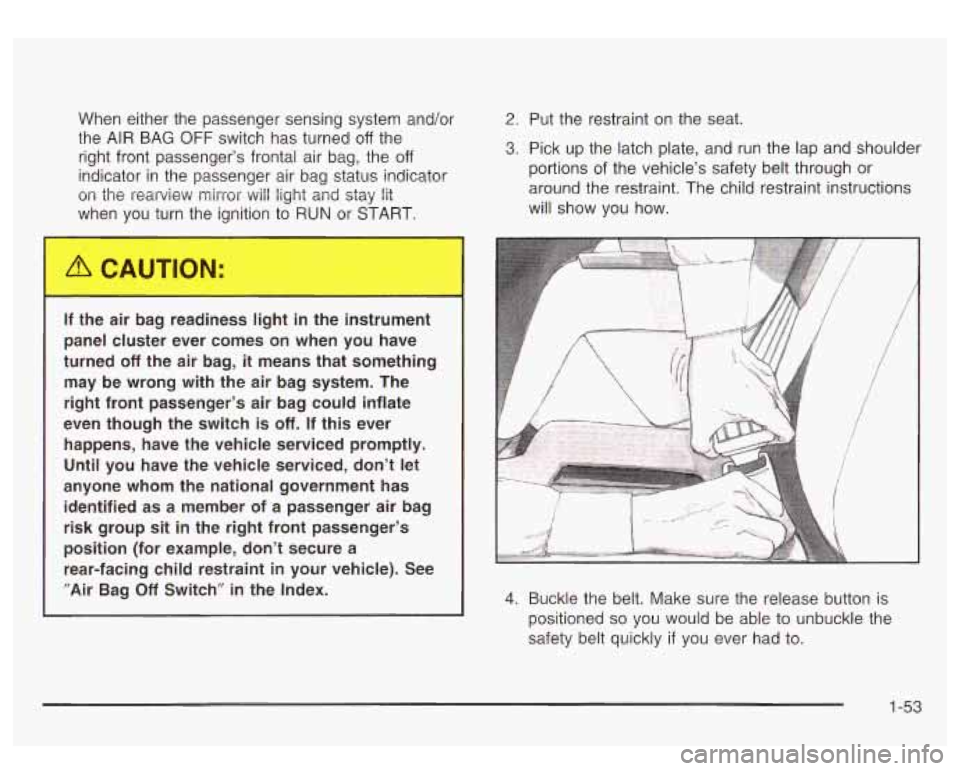
When either the passenger sensing system and/or
the AIR BAG
OFF switch has turned off the
right front passenger’s frontal air bag, the
off
indicator in the passenger air bag status indicator
on the rearview mirror will light and stay lit
when
y-” turn the ignition to RUN or START.
2. Put the restraint on the seat.
3. Pick up the latch plate, and run the lap and shoulder
portions
of the vehicle’s safety belt through or
around the restraint. The child restraint instructions
will show you how.
If the air bag readiness light
in the instrument
panel cluster ever comes
on when you have
turned
off the air bag, it means that something
may be wrong with the air bag system. The
right front passenger’s air bag could inflate
even though the switch
is off. If this ever
happens, have the vehicle serviced promptly.
Until
you have the vehicle serviced, don’t let
anyone whom the national government has identified as a member of a passenger air bag
risk group sit in the right front passenger’s
position (for example, don’t secure a
rear-facing child restraint
in your vehicle). See
”Air Bag
Off Switch” in the Index. 4. Buckle the belt. Make sure the release button is
positioned
so you would be able to unbuckle the
safety belt quickly
if you ever had to.
1-53
Page 62 of 428
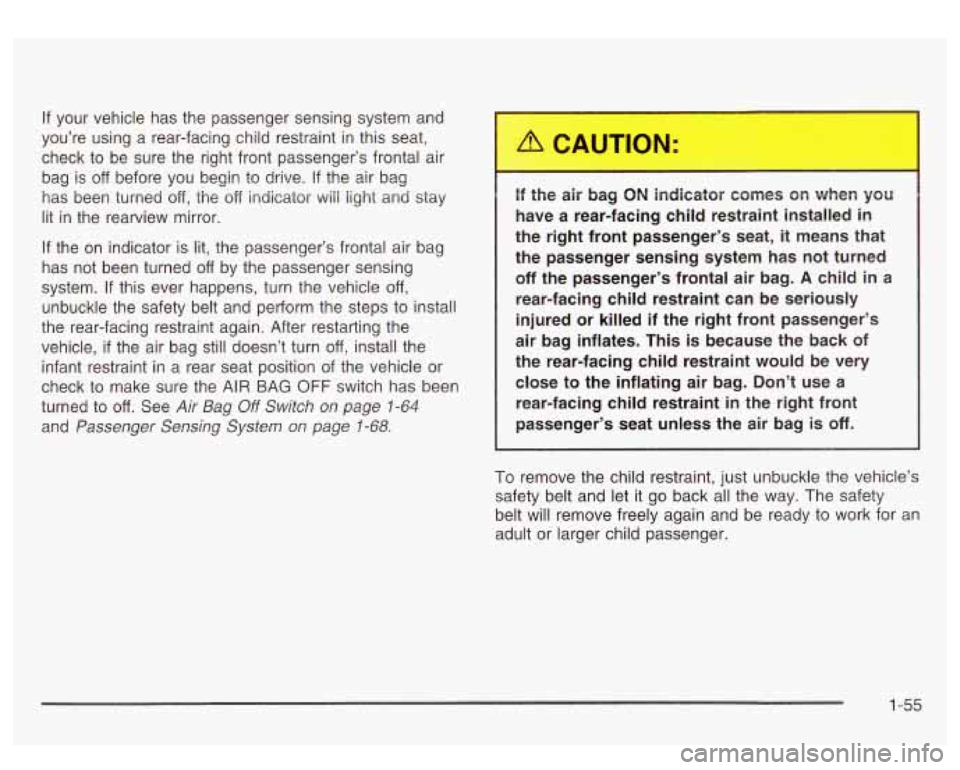
if your vehicle has the passenger sensing system and
you’re using a rear-facing child restraint in this seat,
check to be sure the right front passenger’s frontal air
bag is
off before you begin to drive. If the air bag
has been turned
off, the off indicator wiii iight and stay
lit in the rearview mirror.
If the on indicator is lit, the passenger’s frontal air bag
has not been turned
off by the passenger sensing
system. If this ever happens, turn the vehicle
off,
unbuckle the safety belt and perform the steps to install
the rear-facing restraint again. After restarting the
vehicle,
if the air bag still doesn’t turn off, install the
infant restraint in a rear seat position of the vehicle or
check to make sure the AIR
BAG OFF switch has been
turned to
off. See Air Bag Off Switch on page 1-64
and Passenger Sensing System on page 1-68.
If the air bag ON indicator comes on when you
have a rear-facing child restraint installed in
the right front passenger’s seat, it means that
the passenger sensing system has not turned
off the passenger’s frontal air bag. A child in a
rear-facing child restraint can be seriously
injured or killed if the right front passenger’s
air bag inflates. This
is because the back of
the rear-facing child restraint would be very close to the inflating air bag. Don’t use a
rear-facing child restraint
in the right front
passenger’s seat unless the air bag
is off.
To remove the child restraint, just unbuckle the vehicle’s
safety belt and let it go back all the way. The safety
belt will remove freely again and be ready to work for an
adult or larger child passenger.
1-55
Page 75 of 428
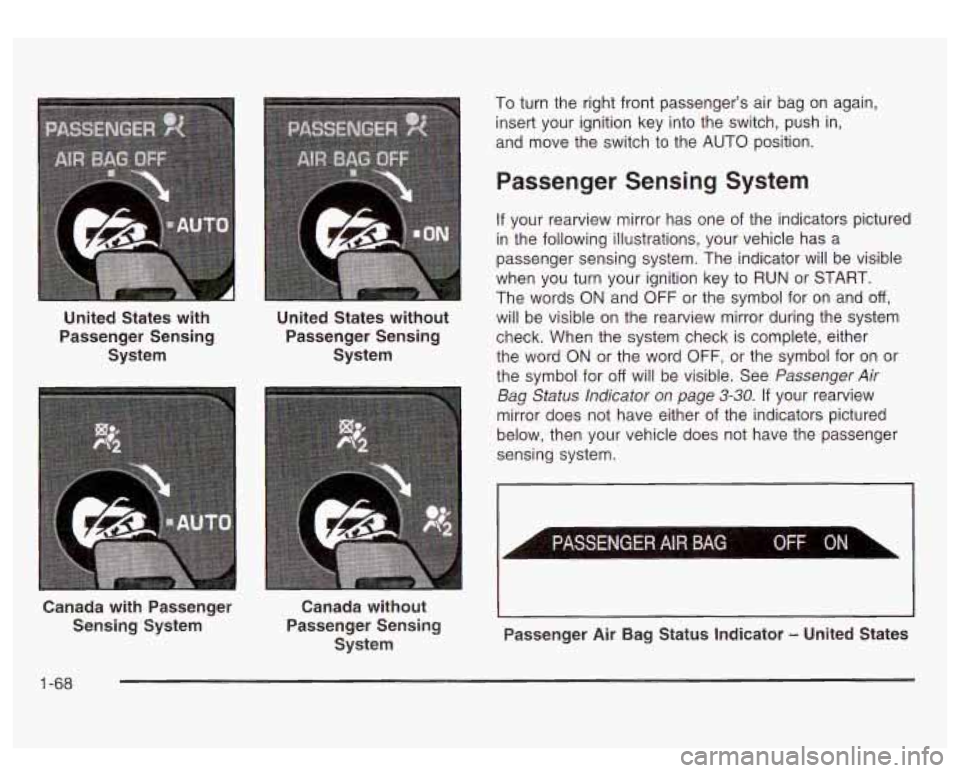
United States with United States without
Passenger Sensing Passenger Sensing
System System
2anada with Passenger
Sensing System Canada
without
Passenger Sensing System To
turn the right front passenger’s air bag on again,
insert your ignition key into the switch, push in,
and move the switch to the AUTO position.
Passenger Sensing System
If your rearview mirror has one of the indicators pictured
in the following illustrations, your vehicle has a
passenger sensing system. The indicator will be visible
when you turn your ignition key to RUN or START.
The words ON and
OFF or the symbol for on and off,
will be visible on the rearview mirror during the system
check. When the system check is complete, either
the word ON or the word
OFF, or the symbol for on or
the symbol for
off will be visible. See Passenger Air
Bag
Status lndicator on page 3-30. If your rearview
mirror does not have either
of the indicators pictured
below, then your vehicle does not have the passenger
sensing system.
Passenger Air Bag Status Indicator
- United States
1-68
Page 82 of 428

Section 2 Features and Controls
Keys ............................................................... 2-2
Remote Keyless Entry System
......................... 2-3
Remote Keyless Entry System Operation
........... 2-4
Doors and Locks
............................................. 2-6
Door Locks
.................................................... 2-6
Power Door Locks
.......................................... 2-7
Rear Doors
................................................... 2-8
Tailgate
........................................................ 2-8
Windows
........................................................ 2-10
Power Windows
............................................ 2-11
Swing-Out Windows
...................................... 2-11
Sun Visors
................................................... 2-12
Theft-Deterrent Systems
.................................. 2.13
Content Theft-Deterrent
................................. 2.13
Passlock@
.................................................... 2.14
Starting and Operating Your Vehicle
................ 2.15
New Vehicle Break-In
.................................... 2.15
Ignition Positions
.......................................... 2.15
Starting Your Engine
..................................... 2.16
Engine Coolant Heater
.................................. 2.17
Automatic Transmission Operation
................... 2.18
All-Wheel Drive
............................................ 2-21
Parking Brake
.............................................. 2-22
Shifting Into Park
(P) ..................................... 2-23 Shifting
Out
of Park (P) ................................. 2-25
Parking Over Things That Burn
....................... 2-26
Engine Exhaust
............................................ 2-26
Running Your Engine While You Are Parked
.... 2-27
Mirrors
........................................................... 2-28
Automatic Dimming Rearview Mirror with
OnStap, Compass and Temperature
Display
.................................................... 2-28
Outside Power Mirrors
................................... 2-31
Outside Power Foldaway Mirrors
..................... 2-31
Outside Automatic Dimming Mirror
.................. 2-31
Outside Curb View Assist Mirrors
.................... 2-32
Outside Convex Mirror
................................... 2-32
Outside Heated Mirrors
.................................. 2-32
Onstar@ System
............................................. 2-33
HomeLink@ Transmitter
................................... 2-35
Programming the HomeLink Transmitter
........... 2-35
Storage Areas
................................................ 2-39
Glove Box
................................................... 2-39
Cupholder(s)
................................................ 2-39
Center Console Storage Area
......................... 2-39
Tonneau Cover
............................................ 2-39
Vehicle Personalization
................................... 2-42
Memory Seat
............................................... 2-42
2- 1
Page 109 of 428
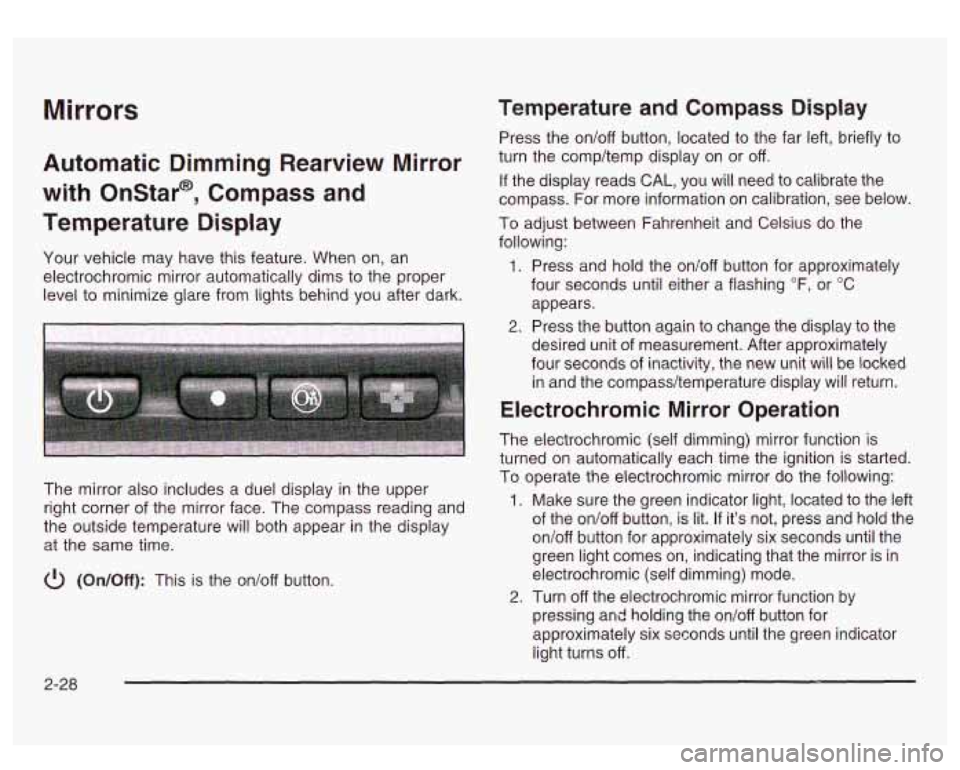
Mirrors
Automatic Dimming Rearview Mirror
with Onstar@, Compass and
Temperature Display
Your vehicle may have this feature. When on, an
electrochromic mirror automatically dims to the proper
level to minimize glare from lights behind you after dark.
The mirror also includes a duel display in the upper
right corner of the mirror face. The compass reading and
the outside temperature will both appear in the display
at the same time.
cl) (On/Off): This is the on/off button.
Temperature and Compass Display
Press the on/off button, located to the far left, briefly to
turn the comp/temp display on or off.
If the display reads CAL, you will need to calibrate the
compass. For more information on calibration, see below.
To adjust between Fahrenheit and Celsius do the
following:
1. Press and hold the on/off button for approximately
four seconds until either a flashing
OF, or "C
appears.
desired unit of measurement. After approximately
four seconds of inactivity, the new unit will be locked
in and the compass/temperature display will return.
2. Press the button again to change the display to the
Electrochromic Mirror Operation
The electrochromic (self dimming) mirror function is
turned on automatically each time the ignition is started.
To operate the electrochromic mirror do the following:
1. Make sure the green indicator light, located to the left
of the on/off button, is lit.
If it's not, press and hold the
on/off button for approximately six seconds until the
green light comes on, indicating that the mirror is in
electrochromic (self dimming) mode.
2. Turn off the electrochromic mirror function by
pressing and holding the on/off button for
approximately six seconds until the green indicator
light turns off.
2-28
Page 112 of 428

Outside Power Mirrors
If your vehicle is equipped
with outside power mirrors,
the controls are located
on the driver’s door
armrest.
Move the selector switch located above the control pad
to the left or right to choose the mirror you want to
adjust, then press the dots located on the four-way
control pad to adjust the mirror.
The mirrors include ground illumination lamps (puddle
lamps) in the base of the mirror. For more information on
these lamps, see
Puddle Lamps under Exterior Lamps
on page 3-1
1.
The mirrors also include a memory function which works
in conjunction with the memory seats. See “Memory
Seats” in the Index for more information.
Outside Power Foldaway Mirrors
If your vehicle is equipped with outside power foldaway
mirrors the mirrors can be folded in toward the body
of the vehicle.
To fold
in the mirrors, move the upper selector switch,
located above the mirror control, to the middle position.
Press the right side of the mirror control to fold the
mirrors toward the body
of the vehicle. The mirror glass
on one or both sides of the vehicle may automatically
adjust before the mirror folds inward. When the
mirror glass or mirror starts moving, you can release the
mirror control.
To return the mirrors and the mirror glass to their
normal position press the left side of the mirror control.
If the mirrors are manually folded, use the power
mirror control to return it to it’s original position.
Outside Automatic Dimming Mirror
The driver’s outside mirror will adjust for the glare of any
headlamps behind you. This feature is controlled by
the on and
off settings on the electrochromic mirror. See
“Electrochromic Mirror Operation” under
Automatic
Dimming Rearview Mirror with Onstat? Compass and
Temperature Display on page
2-28.
2-3 1
Page 113 of 428
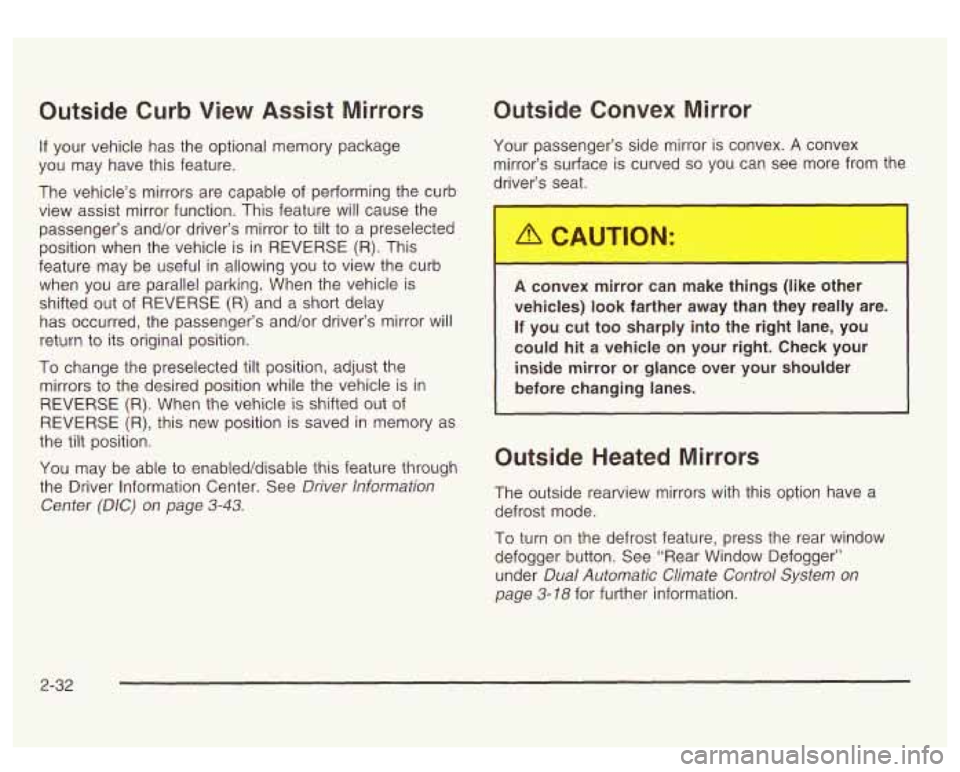
Outside Curb View Assist Mirrors
If your vehicle has the optional memory package
you may have this feature.
The vehicle’s mirrors are capable of performing the curb
view assist mirror function. This feature will cause the
passenger’s and/or driver’s mirror to tilt to a preselected
position when the vehicle is in REVERSE (R). This
feature may be useful in allowing you to view the curb
when you are parallel parking. When the vehicle
is
shifted out of REVERSE (R) and a short delay
has occurred, the passenger’s and/or driver’s mirror will
return to its original position.
To change the preselected tilt position, adjust the
mirrors to the desired position while the vehicle is in
REVERSE (R). When the vehicle is shifted out of
REVERSE (R), this new position is saved in memory as
the tilt position.
You may be able to enabled/disable this feature through
the Driver Information Center. See
Driver Information
Center (DIC) on page
3-43.
Outside Convex Mirror
Your passenger’s side mirror is convex. A convex
mirror’s surface is curved
so you can see more from the
driver’s seat.
A convex mirror can make things (like other
vehicles)
look farther away than they really are.
If you cut too sharply into the right lane, you
could hit a vehicle on your right. Check your
inside mirror or glance over your shoulder
before changing lanes.
Outside Heated Mirrors
The outside rearview mirrors with this option have a
defrost mode.
To turn on the defrost feature, press the rear window
defogger button. See “Rear Window Defogger”
under
Dual Automatic Climate Control System on
page 3-18 for further information.
2-32